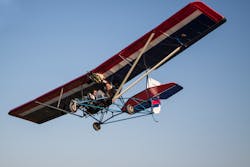Quicksilver Confirms Large Aircraft Order for China
Temecula, CALIFORNIA / May 27, 2014 — Quicksilver Aeronautics announced that it signed a distribution agreement resulting in an order for 77 aircraft in May, 2014. The first two aircraft are presently in the manufacturing process in Quicksilver’s Temecula, California factory and will be shipped to China for their final assembly, testing, and training of Chinese technicians.
“We have been pursuing quality contacts in China and are pleased to associate our company with JH Nanning Group,” said Quicksilver Aeronautics President and CEO, Will Escutia. “The visit to China included the signing of a framework agreement between the Provincial Government of Guanxi and JH Group for the development of general aviation in this province of Southern China.”
As part of the distribution agreement, JH Nanning Group became the exclusive distributor of Quicksilver in China. Negotiations concluded successfully between Liang Ming, president and CEO of Guangxi Jihang General Aviation Co., Ltd. and Quicksilver’s Escutia.
“The interest of the Chinese government to develop high-tech industries is evident,” observed Escutia. Quicksilver was invited in a tour of the area where the building of the new China Aeronautical University for 16,000 students is being constructed. Jiang Xianfa, chairman of Investment Promotion Group Government Laibin, invited the California aircraft manufacturer to be part of this big project which encompasses the development of a new generation of aircraft designed by Chinese engineers.
"We buy what we produce," said Mr. Xianfa.
The first phase of this project between Quicksilver and JH Nanning Group involves the establishment of distributors and sub-distributors in China to satisfy the needs of a growing market. Quicksilver aircraft will be assembled in China. To jumpstart the activity, Quicksilver will produce kits for shipment to China where they will be reassembled and test flown. Quicksilver has delivered more than 15,000 of its well known kits around the USA and the world and has highly refined their business model.
In a second phase and to satisfy expected Chinese demand, manufacturing of components for aircraft is being considered. Further plans are being drawn to incorporate research and development once the China Aeronautical University is in operation.
This expansion into the burgeoning Chinese market marks a major success for Quicksilver barely one month after the company won FAA acceptance to produce their Sport S2SE model as a fully-built Light-Sport Aircraft. They company will continue to offer kits both as ELSA and Experimental Amateur Built versions, ensuring a range of price points, all very affordable. Quicksilver’s Sport S2SE is offered at the retail price of $39,999, making it one of the lowest priced SLSA models available. Amateur-built kits remain available at lower cost as do Experimental LSA.
The company is creating three manufacturing locations in the United States, a method allowed under the ASTM Industry Consensus Standards program and FAA regulations. An expansion into China follows this model and sets the stage for the Quicksilver enterprise to grow briskly as its long proven and modestly priced aircraft should be well received in that nation.
FACTS ABOUT QUICKSILVER AERONAUTICS
Quicksilver Aeronautics, under new ownership since 2012, is the most prolific builder of light aircraft kits in the world, with more than 15,000 units flying. Quicksilver builds the MX series including the Sprint, Sprint II, Sport, Sport II, Sport 2S and the GT series including the single seat GT 400 and the two place GT 500. All aircraft models have successfully been included on FAA’s approved-kit list. The GT 500 is the first aircraft approved by FAA under the Primary Aircraft category (1993) and work is underway to gain FAA acceptance of the Sport 2S and GT 500 as Special Light-Sport Aircraft. Quicksilver has dealers throughout the USA and the world with thousands flying in nearly 100 countries. The brand has an enviably good safety record owing significantly to exceptional ease of flight, thorough engineering, and long experience dating to the early 1970s.


